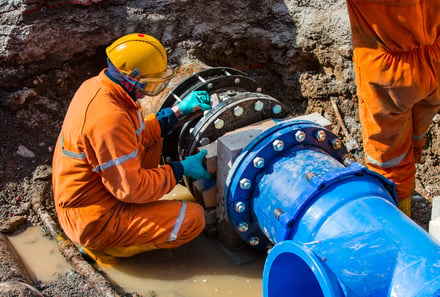
Water hammer is just one of many phenomena that can turn a normal day of slurry pumping into a nightmare. Since the consequences of water hammer can be severe, pump operators must understand what it is, how it occurs, and how to avoid it.
Water hammer basics
Water hammer, also known as hydraulic shock, is a term for the destructive pressure surge and accompanying shock wave that takes place in piping systems when the rate of flow changes suddenly. That shift causes a large vapor pocket to form within the pipeline; when the pocket collapses, a powerful, bidirectional pressure wave propagates away from the source at a high speed. In the most extreme cases, the magnitude of this shock wave reaches up to 100 times the closure velocity of the pocket. This force can actually rupture the pump shell!
The most well-known causes of water hammer are sudden valve closure and other forms of flow restriction. In cases where one of these is the cause, pump operators can easily eliminate water hammer by following proper valve closure procedures.

However, the cause of water hammer may depend on the pumping environment. In the phosphate industry, for instance, water hammer is most common in pit pump applications. There, the suction pipe can become blocked during operation, rather than during valve closure. Water hammer can also occur during the filling of long pipelines, many of which have low points that may not drain completely. When these pipelines are filled quickly, water hammer may occur where the flowing fluid and the stationary fluid meet.
Diagnosing water hammer
Since water hammer manifests as a shock wave, it is difficult to predict its point of origin; therefore, few cases are diagnosed until after a rupture. Anyone or anything in close proximity to the pipeline is at risk in the event of water hammer and the resulting pipeline movement, so pump operators should be extra cautious when there is a chance of water hammer.
Water hammer is not always so destructive, however. In less severe cases, you may hear a banging or hammering noise; it may also bend or move the pipe or its support.
More than cavitation
It may be tempting to confuse water hammer with cavitation. While cavitation can increase the risk of water hammer, cavitation itself is not always so destructive. Cavitation involves many small, localized vapor pocket implosions, whereas water hammer involves the collapse of a single large vapor pocket. Cavitation damage builds up over time before causing a part to fail; conversely, a single instance of water hammer may cause catastrophic damage.
Extreme cases of cavitation can occasionally result in water hammer. For instance, when cavitation is severe enough to impede pumping, but not severe enough to stop operation entirely, a vapor pocket can form in the pipeline. When pumping resumes, the pocket collapses, thereby causing water hammer.
Solutions
The best method for coping with water hammer is to avoid creating it in the first place. Since in many cases the cause is rapid valve closure, operators should always close the valve correctly. In cases where the suction is blocked, such as in the pit pump installation, operators should stop the pumps in the same sequence they would use for a controlled shutdown of all pumps in the pipeline. This will allow the vapor pocket to close at the lowest possible velocity and will minimize the shock wave’s magnitude.
Operators in these situations may attempt to control the movement and position of the suction pipe entrance to keep it from becoming blocked. However, the pipe may still become blocked, especially if there is a slump in the mining or dredging face. Consider the risks carefully before moving the suction pipe entrance, as it may cause water hammer.
By understanding and identifying the causes of water hammer, and by following proper operating procedures, operators can prevent disaster. Of course, the recommended method may depend on your pumping environment and may require expert help.
